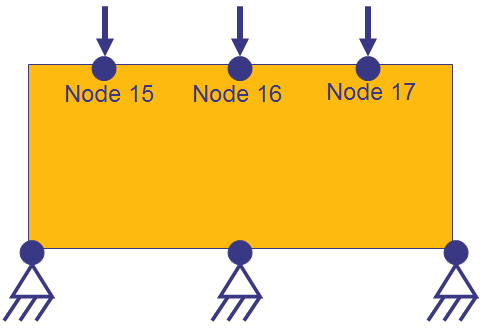Group Operations for Displacements | ||
| ||
The picture below shows a structure loaded at the nodes 15, 16 and
17. The y-displacement of these three nodes should be minimized or applied
in a set of constraints using GROUP_OPER=MAX or GROUP_OPER=SUM.
 |
Use in Objective Function
Initially, a node group is defined containing the nodes 15, 16 and 17 (see figure above) yielding:
GROUP_DEF
ID_NAME = DISP_NODES
TYPE = NODE
FORMAT = LIST
LIST_BEGIN
15, 16, 17
END_
GROUP_OPER = MAX
Based on the node group a design response for the displacements in y-directions are defined
in a DRESP using GROUP_OPER=MAX yielding:
DRESP
ID_NAME = DRESP_DISP_MAX
DEF_TYPE = SYSTEM
TYPE = DISP_Y
LC_SET = STATIC,1,
ND_GROUP = DISP_NODES
GROUP_OPER = MAX
END_
Internally, SIMULIA Tosca Structure generates three DRESPs. One DRESP for the displacement
of node 15, one DRESP for the displacement of node 16 and one
DRESP for the displacement of node 17.
If one then applies the DRESP in the objective yielding:
OBJ_FUNC
ID_NAME = MIN_DISP_MAX
DRESP = DRESP_DISP_MAX
TARGET = MIN
END_
SIMULIA Tosca Structure then sums up the three displacements like the following:
Remark: If you want to minimize the maximum of the three
displacements you need to define an objective function with target MIN_MAX
operating on three design responses (one for each node).
Based on the node group a design response for the displacements in y-directions are defined
in a DRESP using GROUP_OPER=SUM yielding:
DRESP
ID_NAME = DRESP_DISP_SUM
DEF_TYPE = SYSTEM
TYPE = DISP_Y
LC_SET = STATIC,1,
ND_GROUP = DISP_NODES
GROUP_OPER = SUM
END_
Internally, SIMULIA Tosca Structure generates one DRESP consisting of the sum of the displacements of the
nodes 15, 16 and 17.
If one then applies the DRESP in the objective yielding:
OBJ_FUNC
ID_NAME = MIN_DISP_SUM
DRESP = DRESP_DISP_SUM
TARGET = MIN
END_
SIMULIA Tosca Structure then sum up the three displacements like the following:
Alternatively, one could also define three DRESPs for each node like the
following:
DRESP
ID_NAME = DRESP_DISP_1
DEF_TYPE = SYSTEM
TYPE = DISP_Y
NODE = 15
LC_SET = STATIC,1
GROUP_OPER = MAX or SUM
END_
DRESP
ID_NAME = DRESP_DISP_2
DEF_TYPE = SYSTEM
TYPE = DISP_Y
NODE = 16
LC_SET = STATIC,1
GROUP_OPER = MAX or SUM
END_
DRESP
ID_NAME = DRESP_DISP_3
DEF_TYPE = SYSTEM
TYPE = DISP_Y
NODE = 17
LC_SET = STATIC,1
GROUP_OPER = MAX or SUM
END_
And then add the three design response in the objective function:
OBJ_FUNC
ID_NAME = MIN_DISP_SUM
DRESP = DRESP_DISP_1
DRESP = DRESP_DISP_2
DRESP = DRESP_DISP_3
TARGET = MIN
END_
Meaning that the objective function minimizes the following:
Remark: Consequently, it can be concluded that all three ways of
defining the optimization leads to the same objective function. In this case, it is strongly
recommended that you combine the displacements using GROUP_OPER = SUM,
which results in a better performance.
Use in Constraints
Initially, a node group is defined containing the nodes 15, 16 and 17 (see figure above) yielding:
GROUP_DEF
ID_NAME = DISP_NODES
TYPE = NODE
FORMAT = LIST
LIST_BEGIN
15, 16, 17
END_
GROUP_OPER = MAX
Based on the node group a design response for the displacements in y-directions are defined
in a DRESP using GROUP_OPER=MAX yielding:
DRESP
ID_NAME = DRESP_DISP_MAX
DEF_TYPE = SYSTEM
TYPE = DISP_Y
LC_SET = STATIC,1,
ND_GROUP = DISP_NODES
GROUP_OPER = MAX
END_
Internally, SIMULIA Tosca Structure generates three DRESPs. One DRESP for the displacement
of node 15, one DRESP for the displacement of node 16 and one DRESP for the
displacement of node 17.
If you apply the DRESP in a constraint yielding:
CONSTRAINT
ID_NAME = CONSTRAINT_MAX
DRESP = DRESP_DISP_MAX
MAGNITUDE = ABS
LE_VALUE = <value>
END_
SIMULIA Tosca Structure then generates three displacement constraints like the following:
|
|
GROUP_OPER = SUM
Based on the node group a design response for the displacements in y-directions are defined
in a DRESP using GROUP_OPER=SUM yielding:
DRESP
ID_NAME = DRESP_DISP_SUM
DEF_TYPE = SYSTEM
TYPE = DISP_Y
LC_SET = STATIC,1,
ND_GROUP = DISP_NODES
GROUP_MAX = SUM
END_
Internally, SIMULIA Tosca Structure generates one DRESP consisting of the sum of the displacements of the
nodes 15, 16 and 17.
If you apply the DRESP in a constraint yielding:
CONSTRAINT
ID_NAME = CONSTRAINT_MAX
DRESP = DRESP_DISP_MAX
MAGNITUDE = ABS
LE_VALUE = <value>
END_
SIMULIA Tosca Structure then generates a single displacement constraint like the following:
Alternatively, one could also define three DRESPs for each node like the
following:
DRESP
ID_NAME = DRESP_DISP_1
DEF_TYPE = SYSTEM
TYPE = DISP_Y
NODE = 15
LC_SET = STATIC,1
GROUP_OPER = MAX or SUM
END_
DRESP
ID_NAME = DRESP_DISP_2
DEF_TYPE = SYSTEM
TYPE = DISP_Y
NODE = 16
LC_SET = STATIC,1
GROUP_OPER = MAX or SUM
END_
DRESP
ID_NAME = DRESP_DISP_3
DEF_TYPE = SYSTEM
TYPE = DISP_Y
NODE = 17
LC_SET = STATIC,1
GROUP_OPER = MAX or SUM
END_
And then add the three design response in three constraints:
CONSTRAINT
ID_NAME = CONSTRAINT_1
DRESP = DRESP_DISP_1
MAGNITUDE = ABS
LE_VALUE = <value>
END_
CONSTRAINT
ID_NAME = CONSTRAINT_2
DRESP = DRESP_DISP_2
MAGNITUDE = ABS
LE_VALUE = <value>
END_
CONSTRAINT
ID_NAME = CONSTRAINT_3
DRESP = DRESP_DISP_3
MAGNITUDE = ABS
LE_VALUE = <value>
END_
SIMULIA Tosca Structure then generates three displacement constraints like the following:
|
|
Consequently, it can be concluded that there is fundamental difference in the constraints
if a node group (ND_GROUP) consisting of more than one node is applied and
the choice of GROUP_OPER.